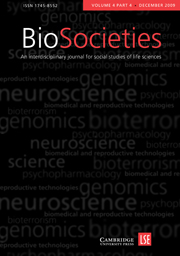Crossref Citations
This article has been cited by the following publications. This list is generated based on data provided by
Crossref.
Ortega, Francisco
2009.
The Cerebral Subject and the Challenge of Neurodiversity.
BioSocieties,
Vol. 4,
Issue. 4,
p.
425.
Singh, Ilina
and
Rose, Nikolas
2009.
Biomarkers in psychiatry.
Nature,
Vol. 460,
Issue. 7252,
p.
202.
Davidson, Joyce
and
Smith, Mick
2009.
Autistic Autobiographies and More-Than-Human Emotional Geographies.
Environment and Planning D: Society and Space,
Vol. 27,
Issue. 5,
p.
898.
Solomon, Olga
2010.
Sense and the Senses: Anthropology and the Study of Autism.
Annual Review of Anthropology,
Vol. 39,
Issue. 1,
p.
241.
Chamak, Brigitte
2010.
Autisme, handicap et mouvements sociaux.
Alter,
Vol. 4,
Issue. 2,
p.
103.
Chamak, Brigitte
2010.
L’autisme : surestimation des origines génétiques.
médecine/sciences,
Vol. 26,
Issue. 6-7,
p.
659.
Russell, Ginny
Steer, Colin
and
Golding, Jean
2011.
Social and demographic factors that influence the diagnosis of autistic spectrum disorders.
Social Psychiatry and Psychiatric Epidemiology,
Vol. 46,
Issue. 12,
p.
1283.
Ortega, Francisco
and
Choudhury, Suparna
2011.
‘Wired up differently’: Autism, adolescence and the politics of neurological identities.
Subjectivity,
Vol. 4,
Issue. 3,
p.
323.
Russell, Ginny
and
Kelly, Susan
2011.
Looking beyond risk: A study of lay epidemiology of childhood disorders.
Health, Risk & Society,
Vol. 13,
Issue. 2,
p.
129.
Rapp, Rayna
2011.
Chasing Science: Children’s Brains, Scientific Inquiries, and Family Labors.
Science, Technology, & Human Values,
Vol. 36,
Issue. 5,
p.
662.
Gavreliuc, Alin
2012.
Social autism as a degenerative psychosocial syndrome in changing societies.
Procedia - Social and Behavioral Sciences,
Vol. 33,
Issue. ,
p.
228.
Freeman, John G.
Harrison, Allyson
Holtermann, Ena
Jackson, Ingrid
and
Cunningham, Todd
2012.
Learning About Learning Disabilities.
p.
355.
Bertilsdotter Rosqvist, Hanna
2012.
The politics of joking: narratives of humour and joking among adults with Asperger’s syndrome.
Disability & Society,
Vol. 27,
Issue. 2,
p.
235.
Buchbinder, Mara
2012.
“Sticky” Brains and Sticky Encounters in a U.S. Pediatric Pain Clinic.
Culture, Medicine, and Psychiatry,
Vol. 36,
Issue. 1,
p.
102.
Bracher, Mike
2012.
Investigating Autism: History, Culture and Embodied Difference.
Sociology,
Vol. 46,
Issue. 4,
p.
759.
Verhoeff, Berend
2012.
What is this thing called autism? A critical analysis of the tenacious search for autism's essence.
BioSocieties,
Vol. 7,
Issue. 4,
p.
410.
Bracher, Mike
and
Thackray, Liz
2012.
A History of Autism: Conversations with the Pioneers; Understanding Autism: Patients, Doctors, and the History of a Disorder; The Myth of Autism.
Sociology of Health & Illness,
Vol. 34,
Issue. 7,
p.
1119.
Ginsburg, Faye
and
Rapp, Rayna
2013.
Disability Worlds.
Annual Review of Anthropology,
Vol. 42,
Issue. 1,
p.
53.
Fitzgerald, Des
2013.
Autism, Ignorance, and Love.
Science as Culture,
Vol. 22,
Issue. 3,
p.
394.
Chamak, B.
and
Bonniau, B.
2013.
Changes in the Diagnosis of Autism: How Parents and Professionals Act and React in France.
Culture, Medicine, and Psychiatry,
Vol. 37,
Issue. 3,
p.
405.


